Nothing says beach vacation like having a great tan! In this comprehensive guide I’ve rounded up all the best tips and tricks for tanning, including how to get a tan outside, how to avoid burning, advice on when and how to tan, self tanner recommendations, and more. Everything you need to get a gorgeous tan is all here!

Growing up, I was always trying to get the perfect tan. As a fair-skinned woman, it wasn’t always easy and I’m sorry to say that I did resort to some questionable methods…
like tanning beds,
the infamous orangey, oompah-loompah spray tans
and laying out in the sun for way too long, thinking I didn’t need sunscreen
If you’re reading this I bet you can relate. Now that I’ve been through those things, I’ve learned SO much and have done my research on the most effective ways to get a tan. In this post, I’m sharing some much-improved tanning advice (that’s not only healthier and better for your skin) but will also help you get the gorgeous tan you’re craving. After all, who wants to spend their vacation sunburned and miserable?
Disclosure: Any tips or products shared are things I truly believe in. If you take action (ie make a purchase) after clicking one of the affiliate links, I’ll earn some money which helps me continue creating travel content for you. Compassandcoastline.com is a participant in the Amazon Services LLC Associates Program, an affiliate advertising program designed to provide a means for sites to earn advertising fees by advertising and linking to amazon.com. Each of your purchases through our Amazon affiliate links supports our cause at no cost to you. Thank you for your support!
Protect The Skin You’re In! Getting A Tan Safely
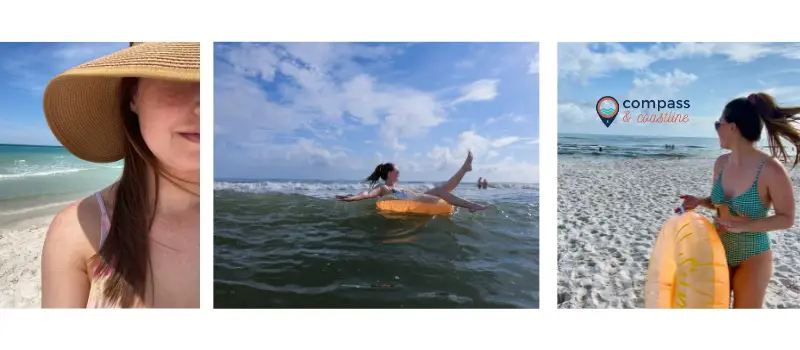
First and foremost protect the skin you’re in! It might seem counterintuitive to wear sunscreen if your goal is to get a tan, but it’s actually really smart and 100% necessary. If you skip sunscreen you’re putting yourself more at risk to burn and when it comes to getting a tan, slow and steady is the goal. Wearing SPF of 30 to 50 means that your skin is somewhat protected, because sunscreen is designed to filter UV rays and prevent sunburn. But it will not prevent the production of melanin, meaning our skin’s color will still deepen (aka a tan!)
Sunscreen and getting a tan can go hand-in-hand! If you haven’t found a sunscreen yet that you really love, check out my recommendations below. These are some of my favorites (and trust me I’ve tried a TON of sunscreens working in the beauty industry and living near the beach!) are Supergoop, Farmacy Beauty and Biossance.
What Time of Day is Best?
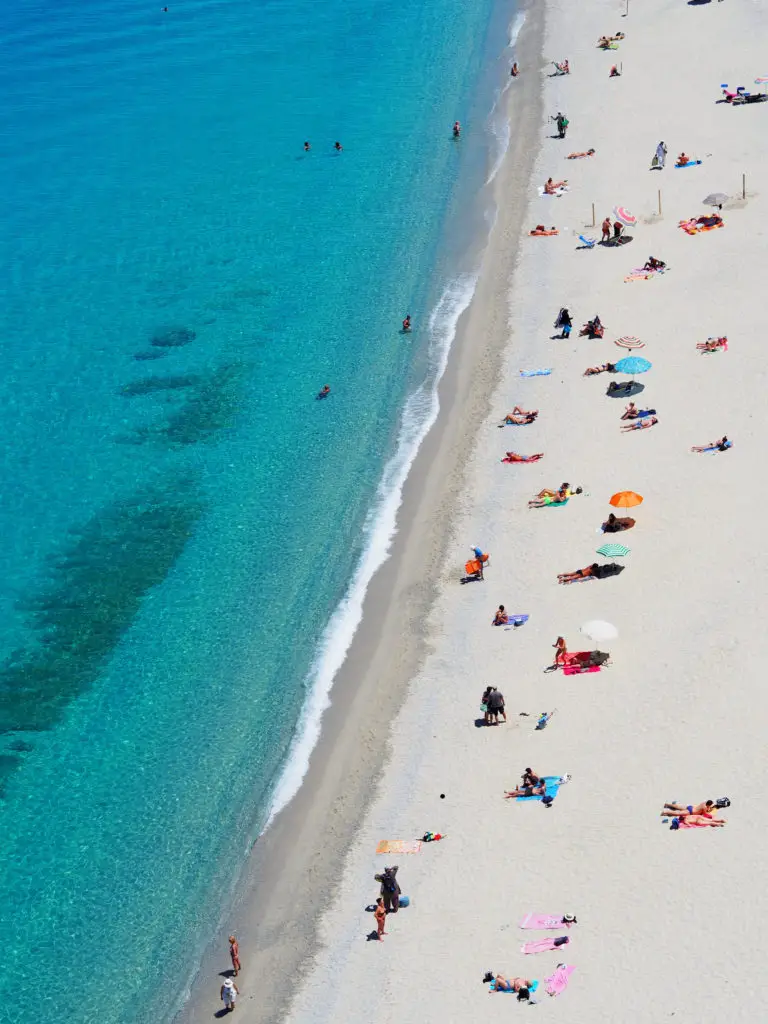
The sun is typically at its strongest from 10 a.m. to 2 p.m. Your instinct might tell you to be in the sunshine during that time to get the best tan, but depending on your skin tone that might be too much. To gradually get exposure, consider tanning during morning or late afternoon hours instead. You’ll still feel the effects of the sun but without as much intensity (and you can stay out longer without worry).
Did you know that your destination also makes a difference? In certain parts of the world, the ozone layer is thinner or you could be closer to the equator. In both instances the sun is stronger, meaning your tan is going to be intensified. If you’re curious to learn more, check out this interesting read about countries and beaches most exposed to the power of the sun.
How Long Should You Tan?
Knowing how long to stay in the sun is where it can get confusing. Keep that in mind and what works for one person will be different for someone else. Here’s how to figure it out for yourself:
You can also consider how many consecutive days you’re planning to be in the sun. For example, if you were on a week-long vacation at the beach, it makes more sense to tan a little each day instead of cramming it all into a one-day tanning marathon.
Still not sure about how long to tan? I created the chart below as a visual way to think about skin tone and how it affects getting a tan. You can use it to narrow in on your skin type and determine how much time in the sun is best for you:
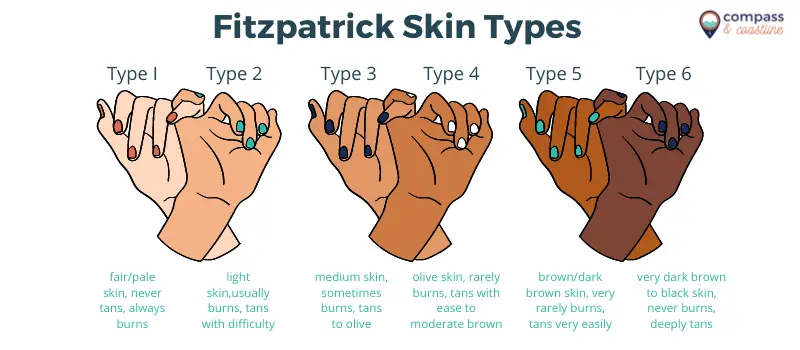
For instance, on the Fitzpatrick skin type scale I’m a type 2, which means that I have naturally light skin and I tend to not tan very well and burn easily. So for me, I would avoid 10 a.m. to 2 p.m. and would likely hit the beach later in the afternoon to avoid the intensity of midday sun. I would also limit my exposure to 1-2 hours and avoid any extended periods. On the other hand, if my friend was a type 5, which is brown skin that tans easily and quickly, she could stay out longer without any problems.
Some other tips to avoid overdoing it with length of time in the sun: look for shade, take breaks, wear a hat and sunglasses, consider covering up body parts that might tan faster than others (for me it’s my face) and even rotating your position to evenly tan different parts of your body. Beach umbrellas are my number one must have for being able to control sun exposure at the beach and get the perfect tan for you. For a full list, check out my post 10 Must-Have Beach Day Essentials for a Perfect Summer Getaway.
How To Get A Tan Without Burning
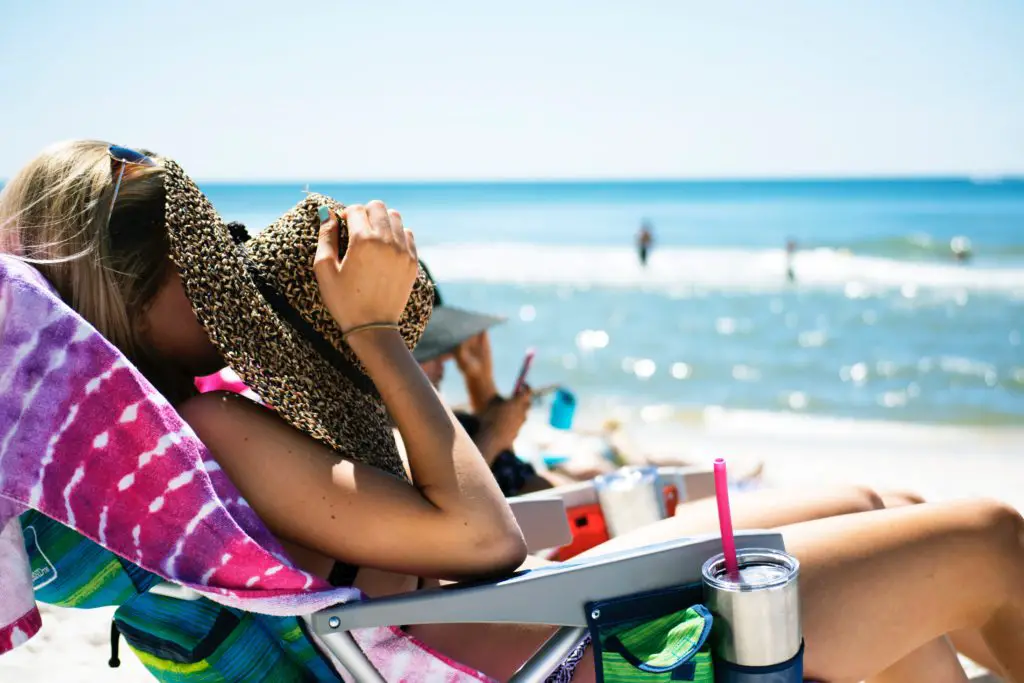
I know you might be wondering how do I get a tan without burning, and it’s a great question because there are a lot of things to consider and it’s unique to each person. So let’s talk a little bit more about how to avoid burning. Some of the biggest reasons our skin burns is from not using/reapplying sunscreen, getting too much exposure, and not factoring in our skin type and tone.
Did you know sunscreen needs to be reapplied every 2 hours? Sunscreen works by either deflecting the sun’s rays (known as a “physical” sunscreen) or absorbing the sun’s rays (known as a “chemical” sunscreen). Both types are effective but what’s important to know is that the results basically wear off after 2 hours. At that point it’s really critical to reapply, otherwise you’re completely exposed and without protection. My advice is to find a sunscreen you actually enjoy and don’t mind wearing, so reapplying won’t feel like a chore.
Have you ever wondered why it seems like you tan faster at the beach? Destination does make a difference, and it all comes down to geography and the UV index, which is like an intensity scale that helps you to understand how strong the sun is. In a sense, the UV index does all of the calculations for you! So you don’t have to worry about all the logistics of when and how to get a tan based on your location. The EPA has a handy tool that allows you to type in your zip code and find out the UV index at your destination, check it out!
Prep Your Skin For Sunshine
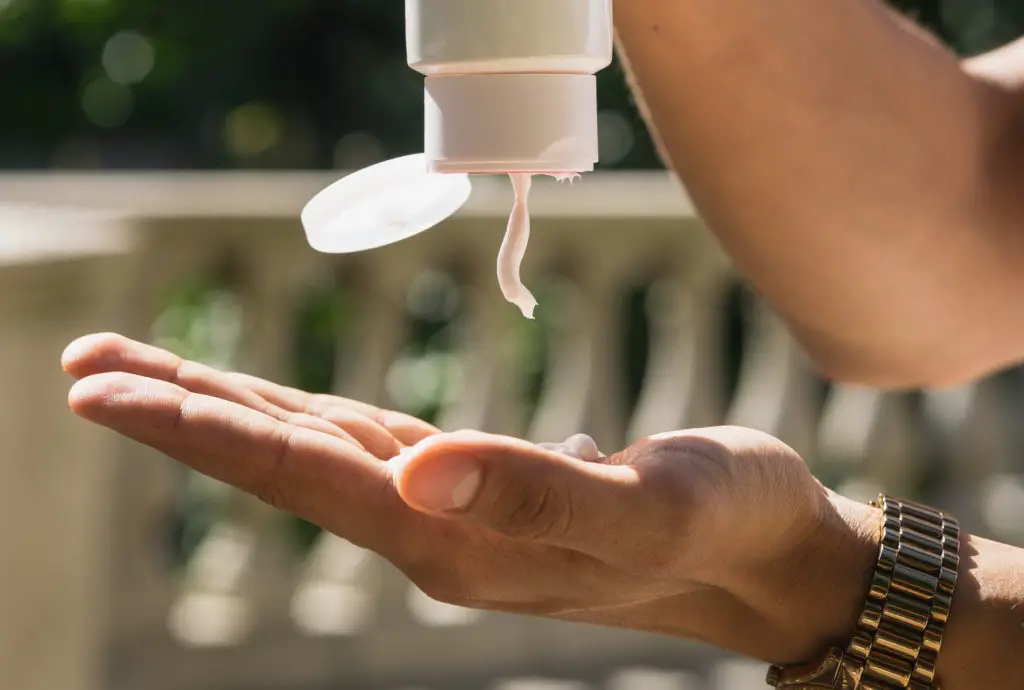
Another tip to help you get a tan is to prep your skin several days before by gently exfoliating in the shower. If you want to kick off the vacation vibes early, I definitely recommend the Sol De Janeiro Bum Bum Body Scrub, it smells absolutely delicious! The exfoliation will help remove dead skin sitting on the surface. Not only will your skin feel softer and more smooth, but it will be less likely to flake. Be sure to follow up with a moisturizer from head to toe because the sun tends to dry out the skin.
Bonus tips: if any of your body lotions contain Alpha Hydroxy Acids I would recommend that you stop using those prior to spending time in the sun. AHAs can increase your sensitivity (not in a good way!) and result in more likelihood to burn. Other things to avoid prior to laying out in the sun: skin that’s freshly waxed or any recent laser treatments. Here are my recommendations for skincare prep products to give you your best tan:
Want to hear more about my beauty product recommendations? Check out my post 10 Beach Vacation Beauty Essentials (and how to use them!)
The Role of Tanning Products and Nutrition
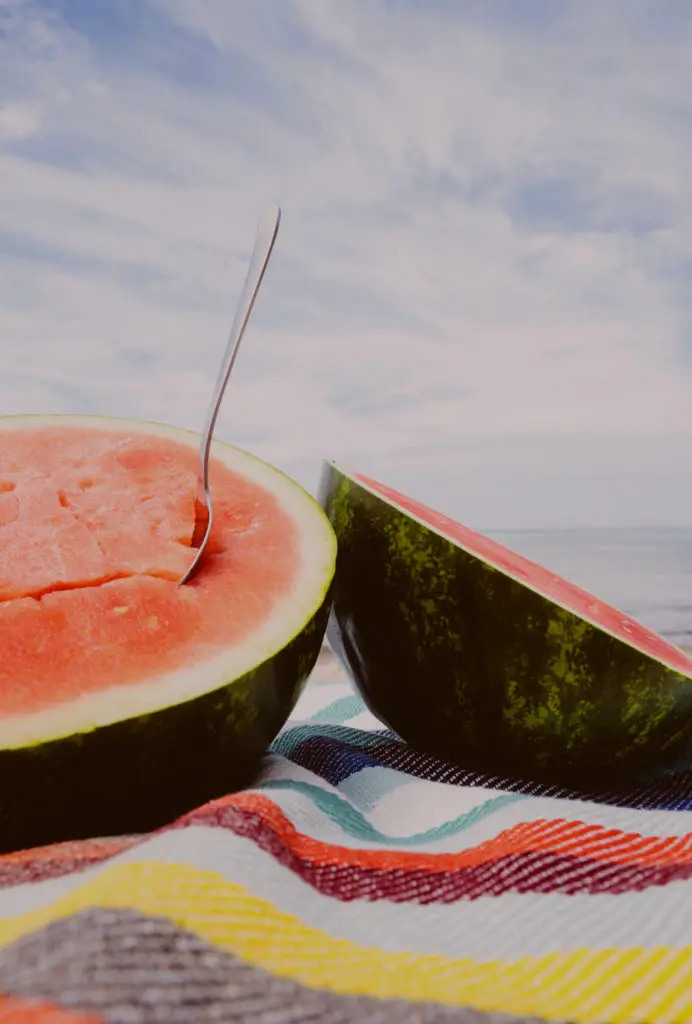
You don’t have to look very far to find products that are claiming to stimulate your skin’s melanin but unfortunately there’s no clinical proof that these types of products work. I’m not a dermatologist or medical expert, so this is not meant to replace any medical advice. Just a word of caution to you, and hopefully in the future with advances in tech, who knows what advancements could be made.
Now for some good news – there are certain nutrients that some studies suggest can boost melanin in our skin – things like antioxidants, Vitamins A, C, and E, and certain herbs. Eating a healthy, nutritious diet helps keep our skin in optimal condition and maximize tanning. Foods like citrus, berries, leafy vegetables, dark chocolate and green tea are all full of antioxidants. As an added bonus some studies even show that antioxidants help counteract the harmful results of the sun. It’s a win-win! Now you have a list of great snack ideas for the beach, too!
One other quick note related to health and getting a tan: certain medications, medical conditions, and even genetic disorders can increase your photosensitivity. It’s always a good idea to consult a medical professional if you think you may be impacted. You can read more here about photosensitivity and the skin if you’re interested.
Tips To Maintain Your Tan
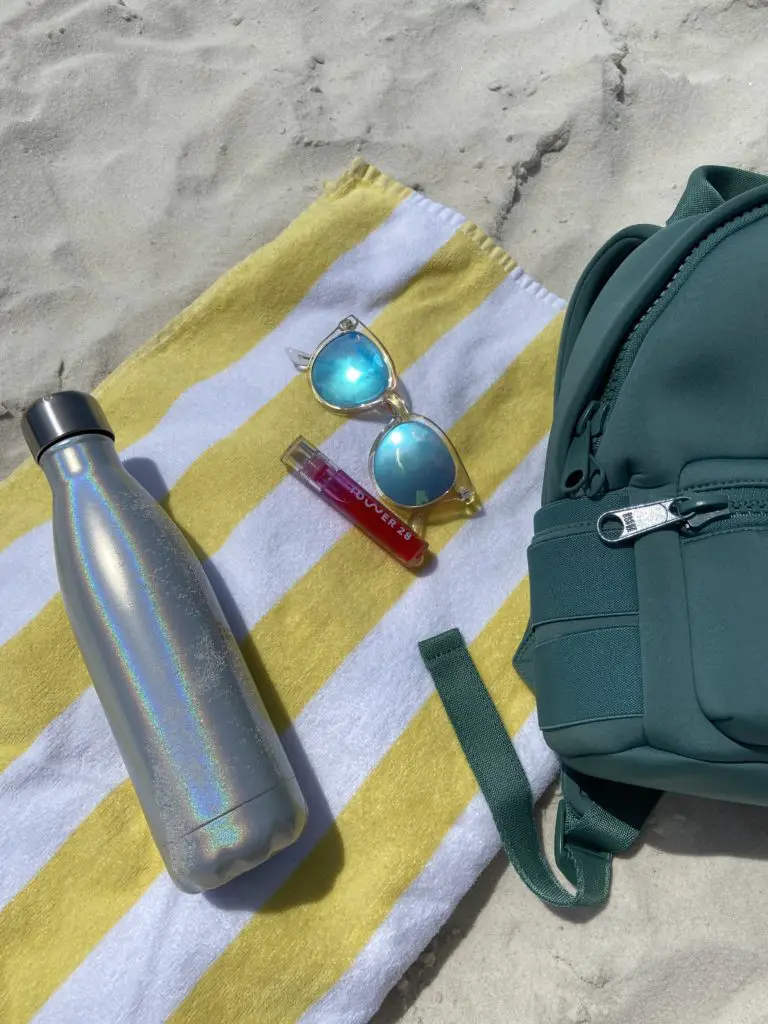
You did it! Now that you have a gorgeous tan, let’s help it last as long as possible. The first important thing to extend the life of your tan is to drink lots of water! Hydrated skin is healthy skin, and your tan will last longer. When I’m at the beach, I love to have my favorite S’well water bottle with me (they’re triple-layered and keep your water super cold!) If you want to try it for yourself, you can get 15% off and free shipping on S’well. Another thing to do is keep your skin moisturized with body lotion. Gentle exfoliation is also a good idea, just be sure to avoid hot showers that will dry out your skin and result in your tan flaking off.
Once your natural tan is starting to fade away, you can embrace gradual tanning lotions or tinted bronzers to give you just a little bit of glow and radiance. The one below by St. Tropez is easily one of the best I’ve ever experienced, and actually smells really good too. Sunless Tanners (also called self tanners) are another good option because they tint the top layers of the skin. You’d be surprised how natural they can look! I’ll be sharing tips on that in the next section, along with some of the best ones I’ve tried and continue to use time and time again.
How To Choose the Best Self Tanner
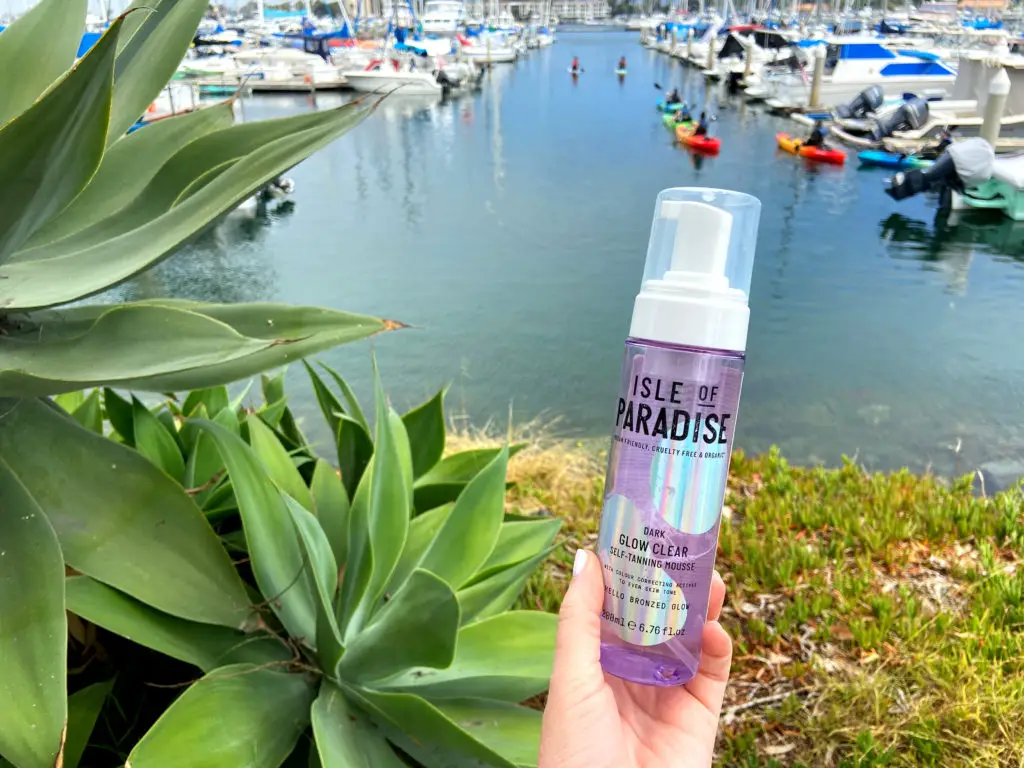
Find Your Formula
Now that you know some tips about how to apply self tanner, let me share a few more bits of advice when you’re trying to choose a self tanner. There are lots of different formulas out there – everything from lotions to sprays, oils, and mousse. Iif you’re just beginning, I would say mousse is a great starting point. It’s really easy to apply, dries quickly and is less messy than some of the other formulas in my opinion.
Another thing to consider is if you want to get a self tanner that has a bronzing tint or if you would rather go with a clear formula. I prefer a clear formula because it doesn’t stain your clothing, so it feels easier to work with and less messy. Other people prefer to have a tinted formula because as you’re applying it’s easier to see where the product is and make sure that you have blended it well without streaks. The type of formula you choose is really personal preference so go with what feels right to you!
Compare Types of Self Tanner
Typically your tan will develop anywhere from six to eight hours after you apply it to your skin. However, there are self tanners on the market that develop faster, and you’ll often see these labeled as “Express” tan. So that’s an option if you don’t like the idea of having it sit on your skin or having to sleep in tanner overnight.
Another piece of advice for choosing the right self tanner for you is to factor in your natural skin tone. If you naturally have a medium skin tone, you can probably go with a formula labeled dark or even extra dark. On the other hand, if your natural skin tone is extremely fair and you pick up that bottle of super extra dark you may not be happy with the results because it’s going to look more artificial in most cases. But test it out for yourself! No judgement if you’re fair and you want to really go for it with a dark shade. I support you, I’ve done that myself and sometimes it works out well.
I know that for a lot of people the scent of self tanner is a turn off. That typical self tanner smell is caused by the key ingredient in the formula responsible for changing the color of our skin. The good news is that there are many brands that have figured out how to make a great self tanner that also smells really good! So don’t be discouraged if you’ve tried self tanners before and haven’t found the one. A few of my top picks are Isle of Paradise and Beauty By Earth.
Getting A Tan the Easy Way: Self Tanner Application Tips
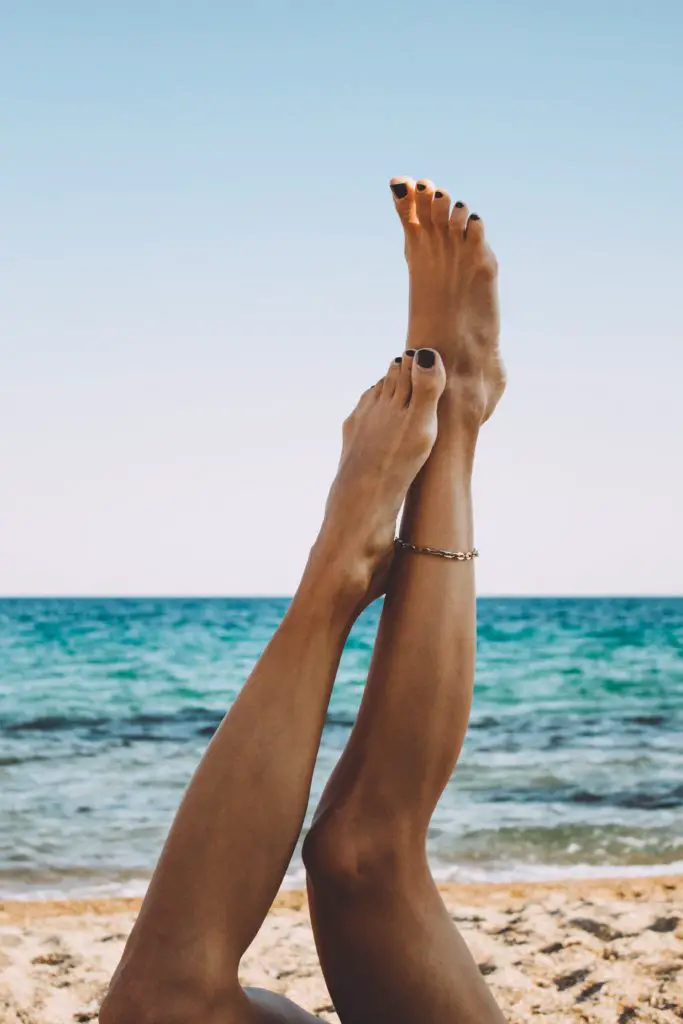
Okay I have a confession to make… this post is all about how to get a tan outdoors but my personal favorite way to get a tan that I swear by and have been doing for years is self tanner. Self tanner often gets a bad reputation for being fake-looking and tricky to apply, but over the years formulas have improved so much and it’s such an easy way to get a tan fast minus the sun exposure. I’m totally hooked and I’m going to share with you my best tips (you know it’s good when people ask if you just got back from vacation!) Here’s my no-fail process to a great faux tan:
- Exfoliate in the shower the day before and pay special attention to rough knees and elbows
- On the day of application prep any dry spots (ie knees, elbows, even underarms) with a lightweight lotion
- Use a tanning mitt to protect your hands and make blending easier
- Apply the product to the mitt, not to your body and blend gently in circular motions (no need to apply tons of pressure)
- I typically work in sections doing one arm at a time, then moving to the next arm, and so on
- When you feel like the tanning mitt almost has no product left, that’s when you want to glide over knees, elbows, ankles, and hands to avoid distributing too much tanner in those bony areas
- Once I’m done applying I use a dry paper towel to remove any excess tanner on the areas listed above
- Now it’s time to wait and stay cool so I turn on the ceiling fan and try not be patient and give the tanner time to completely dry before getting dressed
- Last but not least you’ll want to wait at least eight hours before getting sweaty, working out or showering. My advice is to apply self tanner before bedtime and shower in the morning
Common Myths About Tanning
Since we’re talking about how to get a tan, I thought it would be interesting to take a moment to debunk all of the myths I’ve heard about tanning:
- MYTH: sunburns turn into tans. REALITY: Whether you’re sunburned Fades into a tan or just Fades and leaves you with nothing is really depending on your skin type so it’s not a guarantee
- MYTH: Tanning beds aren’t any worse for you then laying out in the sun. REALITY: Tanning beds are about three to five times stronger then the sun’s intensity. Yikes!
- MYTH: As long as you don’t burn then tanning isn’t harmful. REALITY: Sorry friends, this one is painful to write… but the truth is that a tan is simply evidence of sun damage
- MYTH: If you naturally have darker skin to begin with then you don’t need sunscreen. REALITY: Darker skin people can still develop skin cancer (although it is true that the increase amount of melanin gives them a little bit more protection)
- MYTH: Getting a base tan minimizes the damage from the sun. REALITY: This might surprise a lot of people, and it did me too, but there’s really very little proof that getting a base tan actually does anything
- MYTH: SPF 100 offers double the protection of SPF 50. REALITY: SPF 100 blocks 99% of the sun’s rays and SPF 50 blocks 98%, so it’s only a 1% difference. SPF 100 gives you a false sense of security because you feel like it’s so much better but the truth is that it’s barely a difference
- MYTH: SPF of 20 layered with SPF 10 gives you an SPF of 30. REALITY: You’re only protected with SPF 20 in this instance
- MYTH: I have sunscreen in my makeup so I don’t need to add any more. REALITY: Because of the amount of sunscreen that you need to get the full protection having SPF built into your foundation alone is not enough
Time To Soak Up The Sun!
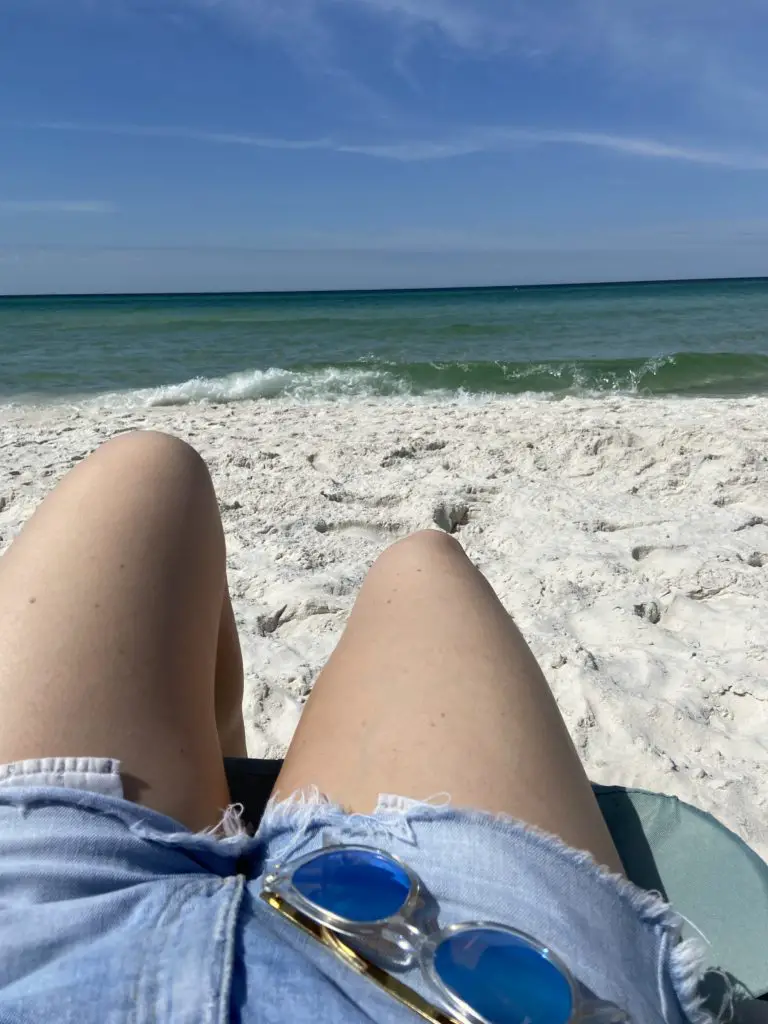
So far we’ve talked about how to get a tan safely, how long to tan, the time of day, we’ve talked about location and UV index, tips on sunscreen and self tanner and even ruled out those myths that we know we’ve all heard before time and time again. I hope you found this post to be really helpful and thorough and gave you a few things to think about on your mission to get a tan!




